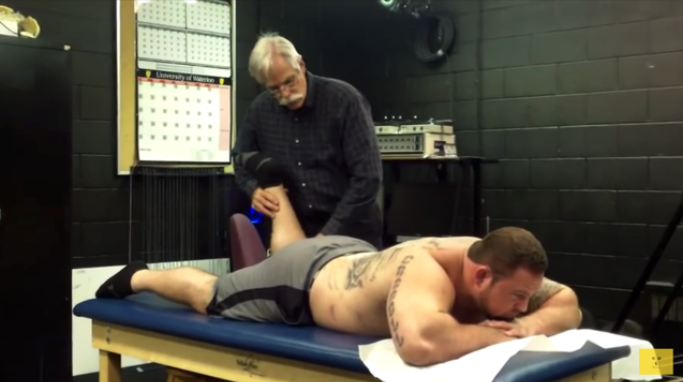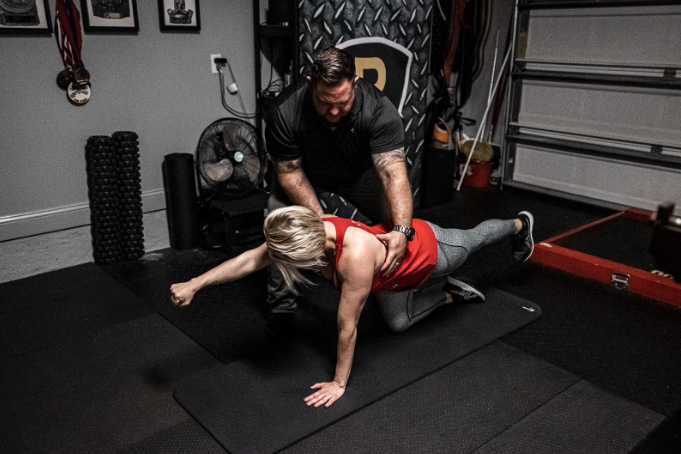
Some people I see have cores like this flounder. They should likely be doing the Big 3.
It's been ten years since I initially visited Dr. Stuart McGill, which you can read about here in the elitefts published series, A Day with Dr. Stuart McGill. Over the last ten years, I've learned more than I ever thought I could. Still, I've made mistakes, perpetuated misconceptions, and confused myself and others with poorly communicated descriptions and newbie-like assumptions about back pain, especially when I first returned from my trip to see McGill in 2013. However, each day I'm improving at understanding, sharing, and helping others with back pain.
This article aims to help those who want to utilize the McGill Big 3 and clarify things I see from clients daily, and you knew this was coming: people on the internet. The errors I see range from a poor understanding of the purpose of the Big 3 and improper application to poor form and execution. Nothing can replace rolling up your sleeves, reading the information, and hearing it from the 'horse's mouth,' in their context, how it was meant to be presented.
YouTube
Misunderstood Concepts Lead to Poor Outcomes
To nobody's surprise, some of McGill's critics don't understand his work because they need to become more familiar with it, which is evident in my experience. Laughably, many have yet to read one of Dr. McGill's books, much less his body of work and 232+ published papers on lower back pain.
For reference, the most straightforward book to consume his methods is Back Mechanic, followed by Gift of Injury, and Ultimate Back Fitness and Performance, 6th Edition. These three books are for the back-injured layperson, strength athlete, or coach. I suggest becoming familiar with McGill's books instead of blindly applying the Big 3.
In my experience, back-pained individuals, professionals, etc., who consumed Back Mechanic would see how practical the book is for anyone with back pain and how little the book focuses on the McGill Big 3. Would it surprise you that the Big 3 is discussed for less than two pages in total?
One thing it does is put the onus on the reader to apply what they read; apply and let the book guide you. The McGill method is not a bend-and-snap chiropractic adjustment, which is passive therapy and takes no effort by the client. Instead, Stu gives you the tools for you to be your clinician.
The only person that can fix you is you.

Don't Conflate Movements with Methods
My first area to address is that the Big 3 are not the McGill method to relieve back pain.
If back-pained individuals, therapists, and other professionals have yet to read Stu's body of work for context, how will they understand the purpose of the McGill Big 3? Context and nuance matter with back pain. Many narrowly view the McGill Method and inaccurately assume that the McGill Big 3 is the McGill method; not even close. In the opening paragraph, I mentioned mistakes, and this is one of them. I would wrongly assume this with other people and think, "Well, the Big 3 helped me so much that EVERYONE should, by default, do them." In truth, it depends. More on this later.
"Ok, Well, for Starters, What is The McGill Big 3, and Why Do it?"
The Big 3 is a three-pronged attack for the core. The McGill Big 3 is so helpful for many due to the years of testing McGill has done on dozens and dozens of core exercises to understand the most bang for your buck and the least amount of spine stressors. Sure, there are many exercises you can utilize to train the core, but they should be spine friendly, especially when talking about someone with a damaged back. After years of experimenting, McGill dubbed the Big 3 for attacking the core from a posterior (Birddog), lateral (Side Plank), and anterior (Curl-Up) standpoint with as little spinal compression and stress as possible. Most people can do these exercises, in some form, pain-free. However, there are exceptions, and why 'it depends.'
"The Big 3 Worsened My Back Pain. Why?"
McGill's Big 3 is not a panacea for back pain. Correctly utilizing the methods (i.e., the Big 3) is paramount. Unfortunately, one must also understand the Big 3's application and context for one's goals, injury history, limitations, etc., before properly giving an exercise prescription. In truth, for some, it can worsen their pain if they are not ready for it. Some suffer from an acute back pain flare from seemingly ANY compression so much that they must REST and do little to nothing until their pain settles and they desensitize. The Big 3 and their various forms can and will worsen some people. Most people do well with the exercises, but not everyone.
In other cases (i.e., for some populations), serious modifications must be made to the Big 3 to cater to the client's needs or limitations. For example, some with poor shoulder health will not do well with a side plank, sometimes even the bird dog. Elderly and obese Clients with bad knees and hips will struggle to get on and off the floor, so modifications are necessary. Each client's injury history, limitations, and pain triggers are unique and must be treated as such. Some clients have to stay in the regressed version of the Big 3 for months until they are ready to progress, while somebody else will be prepared for the significant three progressions within just a few weeks. Again, every client and their injury is unique and must be treated as such.
"The Big 3 is Easy, but Sometimes it Hurts My Back."
Though there are copious videos on the Big 3, most have minor to significant errors and wrong overall execution. But there are also some fantastic videos (like this one) and demos in the books Back Mechanic and Gift of Injury showing proper execution with clear directions and descriptions. Unfortunately, some report the McGill Big 3 worsening their pain until they execute the appropriate version and the correct form. Sadly, some move on without adequately applying the exercises, perpetuating the same nonsense you may have read about the Big 3. My advice is to make sure you are doing them correctly. And if you still need help figuring it out, go to an expert in the McGill method.

Pervasive Errors in The Execution of The Big 3
Birddog: Lack of neutral spine, no bracing abdominal or pec and lat, leg jacked high in the air, no activation of the T-spine via pushing the earth away (as demonstrated correctly in the picture).
Side Plank: Twisting and lack of locking in the ribcage and pelvis as one, not staggering the feet appropriately, and not moving with purpose when rolling (the advanced version shown).
Curl-Up: Drawing in the belly button to activate the transverse abdominis (TA), not pushing out through the interior and exterior obliques, and raising the head too high, causing flexion of the lumbar and C-spine.
Other Errors I See in Execution
- They are not holding the exercise for a time -- 10 seconds, max. They are isometric exercises, not repetition contests.
- Going through the motions, giving little effort and focus. They are only doing them right if they are breaking a sweat.
- Not being present, One should apply the specific cueing to each segment of the body and core while paying attention to each body part.
Lastly, do these exercises daily, not just when back pain reminds you to. Consistency is crucial to success. One of the reasons I was able to come back from my injury was my level of focus, as detailed in my book with Dr. McGill, Gift of Injury (now available on Kindle). Whatever I was doing, whether it was moving well, walking, or doing the Big 3 (which is all I was doing the first couple of months), I did it will 100% present mind and focus, just like I would a world record attempt. When I can get my clients to understand this type of focus necessary, they have a much higher chance of recovery.
Ten years later, I still utilize these exercises daily and do them before every training session as my warm-up. Staying consistent with these exercises and others is one of the most significant reasons I am still pain-free.

A competitive powerlifter since 1999, Brian Carroll is one of the most accomplished lifters in the history of the sport. Having lifted at the elite world-class level since 2005, Brian has well over a decade of world-class lifting experience. He has totaled more than ten times his body weight in three different classes, and both bench pressed and deadlifted over 800 pounds in two different classes. In his career, he’s totaled 2500 over 20 times in 2 different weight classes. Most recently (10.3.20), Brian set the highest squat of all time (regardless of weight class) with 1306 pounds at a bodyweight of 303 pounds.











Anyone who says they are easy is not doing them incorrectly. The sweat will pour out of anyone I will eventually be able to build up. People are not body awareness or movement awareness Thank you again Brian,,, No quick fix no magic pill
Your video imbedded in this article helped me "rehab" disk herniations last year. Can't thank you enough for the content and helping me get back to training again pain free!